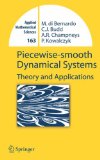

BOOK REVIEW
Piecewise Smooth Dynamical Systems—Theory and Applications, by M. di Bernardo, C. J. Budd, A. R. Champneys and P. Kowalczyk, Springer-Verlag, London, 2008, 483 pages, ISBN-10: 1846280397.
Reviewed by Soumitro Banerjee*
There are a large number of engineering systems whose dynamics contain some kind of switching action. In mechanical engineering, examples of such systems include those with impacts or stick-slip motion between elements. In electrical engineering, power electronic circuits provide good examples. In such systems, switching occurs when the state satisfies a switching condition, which can be visualized as a surface in the state space. It is known that in such “switching dynamical systems,” interesting dynamical phenomena occur as the system trajectory in the state space grazes the switching surface.



Normally, bifurcations are studied by developing a discrete-time model (or map) of the system under study, and naturally in the study of switching dynamical systems one had to study the character of the discrete-time map. The first break in this direction came in the study of the impact oscillator in1991 when the Swedish scientist Arne Nordmark showed that in the neighborhood of a grazing orbit, the leading order term in the map function must have a square root term. This implies that the derivative of the map function approaches infinity as the grazing condition is approached, causing an infinite stretching of the phase space. This leads to interesting dynamics, which were probed by a host of researchers following Nordmark’s formulation.
On the other hand, it was found that in power electronic circuits and most other switching electronic systems the leading order term is linear, and hence the grazing induced bifurcations can be probed by using a piecewise linear normal form map. Nusse and Yorke had studied the dynamics of such maps in the early 1990s, and had obtained the structure of the normal form in one-and two-dimensional piecewise smooth maps. Studies on the dynamics of the piecewise linear map was fruitfully used to explain the dynamical transitions in various power electronic circuits. Way back in the 1970s, some important results pertaining to general n-dimensional maps obtained by the Soviet scientist Mark Feigin proved to be useful in classifying the bifurcations.
However, for a new entrant to the field, the literature available in the form of papers in research journals was getting too diverse and mathematically involved. When such a situation occurs in any field, it becomes necessary to publish a book that presents the available material as a coherent body of knowledge, highlighting the single thread that passes through the different lines of development. The book “Piecewise-Smooth Dynamical Systems—Theory and Applications” authored by Mario di Bernardo, Chris Budd, Alan Champneys and Piotr Kowalczyk (Springer-Verlag, London, 2008) is an important step in that direction.
The book opens with a highly readable introduction, in which the authors set the motivation for studying piecewise smooth dynamical systems through examples of an impacting system, a power electronic dc-dc converter, and the irregular heartbeat observed in some cardiac patients. Having showed that these cases yield piecewise smooth maps on discrete-time modeling, the authors describe the dynamics of such maps in chapters 2, 3, and 4.
Even though a specific book seeks to cover a wide range of topics, every book has a focus. In this book the focus is on the systems that lead to piecewise nonlinear forms of the map in the neighborhood of a grazing orbit. One interesting result in this field is that the map has a square-root singularity if there is a discontinuity in the vector fields at the two sides of the switching surface, while the leading order term has a power of three-half (and hence the map is smooth) if the vector field is continuous. Most of the original insight in this line came from Nordmark, but the results and especially the proofs were not well documented. This book essentially fills the void through a detailed analysis presented in chapters 5, 6, 7, and 8.
The book is well organized, with clear illustrations. The authors have taken care to introduce mathematical concepts (like, for example, the Lie derivative) that could be unknown to a prospective reader. The only problem seems to be the typographical errors—which seems too numerous for a book of this standard—and their occurrence in mathematical statements could confuse the reader.
The thread passing through the whole book is what the authors call “discontinuity-induced bifurcation,” which includes the nonlinear phenomena caused by grazing, sliding, corner collision, etc. Such bifurcation phenomena are observed in a wide range of physical systems. Researchers investigating these phenomena in various areas of the physical, biological, and engineering sciences will benefit from this book.
_________________________________
*S. Banerjee is with the Indian Institute of Technology Kharagpur, India (Email: soumitro@ee.iitkgp.ernet.in)
